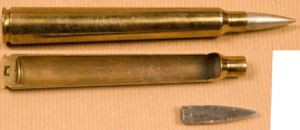7.92mm DS
| 7.92mm DS | ||||||||
|---|---|---|---|---|---|---|---|---|
 | ||||||||
| Type | Rifle, anti-tank | |||||||
| Place of origin |
| |||||||
| Production history | ||||||||
| Designer | Lt. Colonel Tadeusz Felsztyn | |||||||
| Designed | 1931 | |||||||
| Specifications | ||||||||
| Parent case | 7.92×57mm Mauser | |||||||
| Case type | Rimless, bottleneck | |||||||
| Overall length | 132 mm (5.2 in) | |||||||
| Ballistic performance | ||||||||
| ||||||||
The 7.92mm DS was a Polish 7.92 mm anti-tank ammunition designed specifically for use with the karabin przeciwpancerny wz.35 anti-tank rifle. It was based on a standard 7.92×57mm Mauser cartridge, but was much longer (107 mm as opposed to the 57 mm of Mauser cartridge) and was modified to provide higher muzzle velocity and hence more penetrating power.
History
In the late 1920s, the Polish General Staff started the development of a light anti-tank weapon for the Polish infantry. In 1931, Lt. Colonel Tadeusz Felsztyn from the Institute of Armament Technology in Warsaw started the first tests of various low-calibre cartridges. After the tests of German-made Hagler bullets proved the possibilities of such ammunition in perforation of steel plates, the National Ammunition Factory in Skarżysko-Kamienna was ordered to develop its own 7.92 mm cartridge with a muzzle velocity of over 1000 metres per second. After a series of tests, a new DS cartridge was proposed.
The DS ammunition was based on a standard 7.92 mm cartridge used by both the Mauser rifles and the Polish Karabinek wz. 29. The length of the cartridge was extended to 131.2 mm and the overall weight reached 64.25 g. After an additional series of tests the initial copper coating was replaced with a coating made of brass (an alloy of 67% of copper and 23% of zinc).
See also
References
- Zbigniew Gwóźdź, Piotr Zarzycki (1993). Polskie konstrukcje broni strzeleckiej. SIGMA NOT. ISBN 83-85001-69-7.
- Aleksander Smoliński (1992). "Wybrane problemy z historii karabinu przeciwpancernego wz. 35". MWP bulletin.
- Jerzy Sadowski (1995). "Karabin przeciwpancerny wz.35 w fortyfikacjach II RP". Nowa Technika Wojskowa. 11.
- Tadeusz Nowakowski (1995). "Karabin przeciwpancerny wz. 35". Nowa Technika Wojskowa. 6.